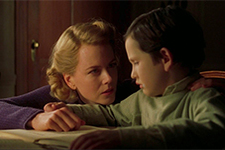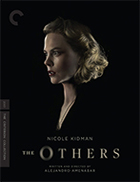The Others (4K UHD) [Blu-Ray]
|

Alejandro Amenábar's The Others is a small masterpiece of atmosphere and tone that slowly and methodically works its way through a classically elegant, yet gut-wrenching ghost story with a brilliantly conceived twist ending that turns the tables on us not just narratively, but emotionally. Amenábar, who wrote, directed, and composed the score, was only 29 at the time, but he already directed two features in Spain: Tesis (1996) and Abre los ojos (1997), the latter of which was remade by Cameron Crowe and Tom Cruise as Vanilla Sky (2001) the same year The Others was released. While his previous films were good, The Others demonstrated in an even more profound way Amenábar's commanding sense of how everything at his disposal—light and dark, noise and silence, steady camera moves and sudden pans—can be used to rachet up the tension to nearly unbearable heights. He earns the scares here with meticulously conception and execution. Granted, there are a few jump-in-your-scene moments that rely on quick cutting and crashing music to startle you, but some of the more blunt techniques are forgivable because Amenábar is so thorough in building up to them. There aren't a lot of sudden-scare moments in the film, but he makes you feel like there could be one around every corner; there is rarely a moment of peace. The story takes place on the small, mist-enshrouded island of Jersey in the English Channel just after the end of World War II—although it has all the repressive anxiety of a Gothic drama, wearing as it does its Henry James influences quite openly. There, a stern and deeply religious woman named Grace (Nicole Kidman), whose husband has gone off to fight on the front in France and has not been heard from since, has retreated with her two young children, Anne (Alakina Mann) and Nicholas (James Bentley). The enormous manor in which they live, with its long, cavernous rooms, many doors, and high, vaulted ceilings, becomes like another world in itself, as the camera never moves beyond the grounds just outside it. It becomes a kind of island in and of itself, cut off from the rest of the world by the seemingly never-ending mist around it (in one sequence, Grace attempts to leave, but is ultimately impeded by the thickness of the mist, which seems to suggest that the world literally ends just outside the manor's gates). Grace and the children cannot leave the manor because Anne and Nicholas have a rare genetic disorder in which they are allergic to light. If exposed to light any brighter than that emitted by a candle, they would burst into sores and eventually suffocate and die. Thus, in one of the film's most brilliantly clever conceits, the house must be kept perpetually dark. So, all the windows in are covered with heavy drapes and curtains, and there is a steadfast rule that, before you can open one door in a room, the one behind you must be shut and locked in order to keep out the light. While this serves the practical atmospheric function of maintaining inky darkness throughout the film—a must in horror movies, especially those dealing with haunted houses—it also slyly inverts the traditional associations we have with light and dark, where light represents safety and dark represents fear and the unknown. The brilliance of Amenábar's narrative conceit in The Others is that he gets to have it both ways: The dark is frightening because it limits human perception and thus knowledge and control, yet the light is even more frightening because it can overtly kill (it is testament to Amenábar's mastery of inverting our expectations that the one of the film's freakiest moments involves sunlight streaming through curtainless windows). In other words, there is no place of safety to which the characters can escape—they are trapped. Near the beginning the film, Grace hires three new servants to help her run the house: Mrs. Mills (Fionnula Flanagan), an older Irish woman who runs the house and takes care of the children; Lydia (Elaine Cassidy) a young mute; and Mr. Tuttle (Eric Sykes), the elderly gardener. For reasons that are left purposefully vague, all of Grace's previous servants had recently left the house with no explanation (it is one of Amenábar's gifts as a screenwriter that every detail is important in one way or another). The three new servants seem decent enough, yet they never seem entirely trustworthy, either. Early on, Amenábar starts dropping hints that the manor might be haunted. Anne, the young girl, is acutely aware of it, as she claims to have had numerous encounters with a family, which includes a mother, a father, a grandmother, and a young boy named Victor. According to Anne, these ghosts believe that the house is theirs and they want Grace and her family to leave. In one of the film's eeriest moments of foreshadowing, Anne relays the message that the ghosts will one day take down all the curtains in the house if they don't leave. But, because Grace is a strict and deeply religious woman, she does believe in the existence of ghosts, that is, until their presence is made all but undeniable. The film centers largely on Nicole Kidman's singularly affecting performance (easily her best work since her gutsy turn in Gus Van Sant's To Die For in 1995). Her cool beauty and tall stature had never been used to such great effect; she is both a portrait of motherly strength and a tattered victim of deep repression and psychological wounds. She holds her religious views as a shield against the darkness in the world, yet at the same time these views limit and constrain her ability to deal with the situation at hand. It is difficult not to feel for her because of the burden she carries: Forced to maintain an enormous house and two small children who will die if they are exposed to too much light, the added presence of the malicious-seeming ghosts is too much. One gets the sense that Grace is always ready to crack, and this added psychological tension adds to the supernatural dread that pervades the entire film. Above all, The Others is an aesthetic tour de force, with Amenábar's studied direction complementing the superb camerawork by veteran Spanish cinematographer Javier Aguirresarobe. Together, they construct the film in swaths of brooding dread and lengthy moments of sustained tension, rather than reveling in the easy sledgehammer approach of shocking images and digital special effects that characterized so many lesser horror films released around that same time, including The Haunting (1998) and The House on Haunted Hill (1999). Instead, it approaches the visual and emotional genius of Jack Clayton's The Innocents (1961). Working in the thick darkness, penetrated only by the weak yellow glow of candles and lanterns, Amenábar and Aguirresarobe build each scene bit by bit, using suggestion of movements and sound rather than gratuitous display. Despite the many encounters between the living and the dead, Amenábar doesn't show us much of anything at all—a swinging door here, a faintly glimpsed shadow there. The Others is a horror film that relies on frightening ideas, rather than just frightening images, which constantly are building in your mind as the film progresses. Amenábar plays with perception and the lack thereof, and when he reveals the twist at the end, we realize that the whole film has been a play on perception and the assumptions we make about how the living and the dead interact. The film requires patience, as Amenábar is in no rush to get to the ending, which may disappoint some. Nevertheless, it is a brilliantly sustained ploy, and it works because the film is not just about getting to the explanation at the end; rather, the individual scenes, because of their attention to character and theme, are justified in and of themselves. The psychological and thematic underpinnings make The Others, in addition to being a good old-fashioned spookfest, a deeper and richer experience than what most run-of-the-mill ghost stories offer.
Copyright © 2022 James Kendrick Thoughts? E-mail James Kendrick All images copyright © The Criterion Collection | |||||||||||||||||||||||||||||
Overall Rating:



 (3.5)
(3.5)
Subscribe and Follow
Get a daily dose of Africa Leader news through our daily email, its complimentary and keeps you fully up to date with world and business news as well.
News RELEASES
Publish news of your business, community or sports group, personnel appointments, major event and more by submitting a news release to Africa Leader.
More Information
